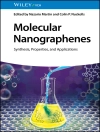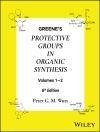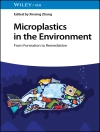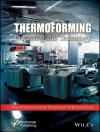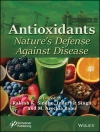This book provides in-depth coverage of the sources, dispersion, life cycle assessment strategies, physico-chemical interactions, methods of analysis, toxicological investigation, and remediation strategies of micro and nanoplastics.
Micro and nanoplastics are the degradation products of large plastic compounds. These degraded polymers enter into the natural environment, including air, water, and food, which leads to various significant threats to human health. The nature of these micro and nanoplastics is persistent and consequently accumulates in the exposed person’s body. Research into microplastics has shown that these particles accumulate in various human organs and impart detrimental effects on humans. To safeguard human health, analysis and remediation strategies are necessary. This book provides a comprehensive overview in 24 chapters on the source, distribution, life cycle assessment strategies, physico-chemical interactions, methods of analysis, toxicological investigation, and remediation strategies of micro and nanoplastics.
Audience
This book is a valuable resource for chemists and polymer scientists in various industries including plastics, fisheries, food and beverages, environmental sciences, agriculture, and medicine, as well as government policymakers.
Содержание
Preface xix
1 Aging Process of Microplastics in the Environment 1
Sílvia D. Martinho, Virgínia Cruz Fernandes, Sónia A. Figueiredo and Cristina Delerue-Matos
1.1 Introduction 1
1.2 Impact of MPs on the Environment 3
1.3 Pristine and Aged Microplastics 4
1.4 Influence of Aging Processes in the Properties of MPs 7
1.5 Simulation in the Laboratory of the Different Aging Effects 10
1.6 Conclusion 13
2 Life Cycle Assessment (LCA) of Bioplastics 21
A. L. Tecorralco-Bobadilla, A. Vázquez-Morillas, G. González-Cardoso and P. X. Sotelo-Navarro
2.1 Introduction 21
2.2 Purpose and Approach of this Chapter 24
2.3 Development of Life Cycle Assessments for Bioplastics 26
2.4 Discussion 47
2.5 Concluding Remarks 54
3 Micro- and Nanoplastics—An Invisible Threat to Human Health 61
Anamika Singh, Anjali Joseph, Thyagaraju Badanavalu Madaiah and Shinomol George Kunnel
3.1 Introduction 61
3.2 Routes of Exposure 62
3.3 Phenomenon of Microplastics in Nourishment and Nutrients 65
3.4 Impact of Microplastics and Nanoplastics on Mammalian Health 66
3.5 Nanoplastics and Microplastics: Effects on Environment and Marine Life 67
3.6 Conclusions 68
4 Microplastics and Nanoplastics and Related Chemicals: The Physical-Chemical Interactions 73
Elsa Cherian, Lakshmi Mohan and Sony Elizebeth Manoj
4.1 Introduction to Micro- and Nanoplastics 73
4.2 Sources and Distribution of Micro- and Nanoplastics 76
4.3 Ecological Impacts of Micro- and Nanoplastics 76
4.4 Food Contamination and Human Exposure to Micro- and Nanoplastics 78
4.5 Toxicological Effects of Micro- and Nanoplastics on Human Health 79
4.6 Conclusions and Recommendations for Mitigating the Toxic Effects of Micro- and Nanoplastics 82
5 Microplastics and Nanoplastics: Sources, Distribution, Behaviors, and Fate 87
Minoo Giyahchi and Hamid Moghimi
5.1 Micro- and Nanoplastics: Principles and Sources 88
5.2 Micro- and Nanoplastic Behavior 89
5.3 Micro- and Nanoplastics’ Distribution and Fate: From Terrestrial and Aquatic Environments to the Human Body 95
5.4 The Effect of Abiotic and Biotic Factors on MNPs’ Behavior and Fate 100
5.5 Conclusions and Future Perspectives 101
6 Microplastics and Nanoplastics in Food 107
Asra Tariq and Ghaus Rizvi
6.1 Introduction 107
6.2 Sources of Micro-Nanoplastics Affecting Food 109
6.3 Impact of Micro-Nanoplastics 114
6.4 Direct Impact on Human Health 114
6.5 Affecting the Food Chain 116
6.6 Detection of Micro-Nanoplastics in Food 116
6.7 Conclusion 118
7 Microplastics: Properties, Effect on the Environment and Removal Methods 125
Anirudh Pratap Singh Raman, Pallavi Jain and Prashant Singh
7.1 An Insight Into Microplastics (MPs) 125
7.2 Microplastic Definitions 126
7.3 Properties of MPs 126
7.4 Primary and Secondary Microplastics 127
7.5 Microbeads 128
7.6 Impacts of MPs 128
7.7 Global Initiatives 133
7.7.1 United Nations Sustainable Development Goal (SDG 14) 133
7.8 Conclusion 134
8 Identification, Quantification, and Presence of Microplastics and Nanoplastics in Beverages Around the World 139
Lobato-Rocha Sheila Liliana Dafne, Cruz-Salas Arely Areanely, Rodríguez-Villa Aylin Geraldine, Tapia-Fuentes Jocelyn and Álvarez-Zeferino Juan Carlos
8.1 Introduction 139
8.2 Methodology 141
8.3 Results 142
8.4 Microplastic Concentrations in Beverages 148
8.5 Microplastic Characterization in Beverages 150
8.6 Human Exposure 155
8.7 Conclusions 156
9 Microplastics and Nanoplastics in Terrestrial Systems 163
Nigina, V. Sajith and Baiju G. Nair
9.1 Introduction 163
9.2 Micro/Nanoplastics in Soil 165
9.3 Micro/Nanoplastics in Plants 168
9.4 Micro/Nanoplastics in Terrestrial Organism 196
9.5 Conclusion 198
10 Microplastics in Cosmetics and Personal Care Products 215
Ana Isabel Hernandez-Soriano, Carolina Martínez-Salvador, Juan Carlos Alvarez-Zeferino, Alethia Vázquez-Morillas and M. Azahara Mesa-Jurado
10.1 Introduction 215
10.2 Methodology 218
10.3 Results 219
10.4 Characterization of Microplastics in PCPs and Cosmetics 220
10.5 Interaction Between Microplastics from PCPs and Other Substances 227
10.6 Toxicity of Microplastics from Personal Care Products and Cosmetics 228
10.7 Worldwide Bans on Microbeads in PCPs and Cosmetics 246
10.8 Conclusions 248
11 Study on Microplastic Content in Cosmetic Products and Their Detrimental Effect on Human Health 253
Venkatramana Losetty, Gosu Nageswara Reddy, C. Hazarathaiah Yadav and K. Sivakumar
11.1 Introduction 253
11.2 Cosmetic Products in India 255
11.3 Source of Plastics and Microplastics 256
11.4 Uptake and Bio-Accumulation of Microplastics 257
11.5 Effect of Microplastic Exposure on Human Health 258
11.6 Alternatives of Microplastics in Cosmetic Products 260
11.7 Conclusions 262
12 Effects of Micro- and Nanoplastics on Human Genome 265
Priyadarshi Mukherjee, Ananya Ghosal, Chayani Mukherjee, Ahana Bhaduri and Mukesh Singh
12.1 Introduction 265
12.2 Source of Micro- and Nanoplastics 266
12.3 Pathways Through Which Micro- and Nanoplastics Enter the Food Chain 270
12.4 Harmful Impacts of Micro- and Nanoplastics on Human Health 272
12.5 Impacts of Micro- and Nanoplastics on the Genome of Humans 274
12.6 Toxic Effects of Micro- and Nanoplastics 276
12.6.1 Several Toxic Effects of Nano- and Microplastics 277
12.7 Case Study on a Small Regional Place of India (Puducherry) 278
12.8 Conclusion 278
13 Harmful Effects of Plastics, Microplastics, and Nanoplastics 285
Niharika Kulshrestha and Anjani Kumar Rai
13.1 Introduction 285
13.2 Generation of MPs and NPs 286
13.3 Techniques for MP and NP Measurement 287
13.4 Various Methods for the Degradation of Plastics 289
13.5 Harmful Effects of Plastics, Microplastics, and Nanoplastics 290
13.6 Measures to Avoid the Further Extension of Harmful Effects of Plastics, Microplastics, and Nanoplastics 293
13.7 Conclusions 294
14 Hazardous Effects of Microplastics and Nanoplastics in Marine Environment 301
Smithi Vibha Toppo, Rakesh Gunasekhar, Revathi Ravind and Shinomol George Kunnel
14.1 Introduction 301
14.2 Fate and Sources of Microplastics 304
14.3 Minimizing the Microplastics in the Environment 309
14.4 Severance of Microplastics from Water and Sediments 310
14.5 Marine Microbial Strains Associated in Degrading Microplastics 311
14.6 Work Done in our Laboratory 313
14.7 Conclusions 313
15 Human Toxicity of Nano- and Microplastics 321
Arely A. Cruz Salas, Maribel Velasco Perez, Ana Laura Tecorralco Bobadilla, Alethia Vázquez Morillas and Rosa María Espinosa Valdemar
15.1 Introduction 321
15.2 Basic Toxicology Concepts 322
15.3 Challenges and Opportunities for Evaluation of Toxicity in Humans 323
15.4 Toxicity Studies With Nano- and Microplastics 330
15.5 Toxicity of Nano- and Microplastic Reported in the Literature 332
15.6 Conclusions 337
16 Plastic-Related Chemicals: Occurrence in Environment and Ecotoxicological Impacts 347
Diana Rede, Cristina Delerue-Matos and Virgínia Cruz Fernandes
16.1 Introduction 347
16.2 Plasticizers 349
16.3 Flame Retardants 358
16.4 Human Exposure to Flame Retardants 367
16.5 Conclusion 369
17 The Invisible Threat: Micronanoplastic Materials 375
Anupama Rajput, Shagufta Jabin, Sadiqa Abbas and Prachika Rajput
17.1 Introduction 375
17.2 Microplastic and Toxic Chemicals 377
17.3 Organic Pollutants 378
17.4 Microplastic Toxic Chemical Interaction 382
17.5 Toxicity to Human 385
17.6 Toxicity to Environment 386
17.7 Impact of Mi Na Ps on Marine Environment and Terrestrial Habitat 387
17.8 Conclusion 388
18 Comparative Analysis of the Toxicity of Micro- and Nanoplastics along with Nanoparticles on the Ecosystem 399
Pooja Mohapatra, Lipsa Shubhadarshinee, Bigyan Ranjan Jali, Aruna Kumar Barick and Priyaranjan Mohapatra
18.1 Introduction 399
18.2 Literature Survey 402
18.3 Exposure to Ecosystem and Translocation 403
18.4 Challenges and Precautions 411
18.5 Conclusions 412
19 Methods for Micro- and Nanoplastic Analysis 415
Veronice Slusarski-Santana, Melissa Longen Panatto, Fernanda Rengel dos Passos, Keiti Lopes Maestre, Carina Contini Triques, Leila Denise Fiorentin-Ferrari and Mônica Lady Fiorese
19.1 Introduction 415
19.2 Micro- and Nanoplastics: Source, Occurrence, and Risks 417
19.3 Pre-Treatment of Micro- and Nanoplastic Samples 419
19.4 Methods for Characterization, Identification, and Quantification of Micro- and Nanoplastics 423
19.5 Conclusions 459
20 New Approaches for Micro(Nano)Plastics Analysis 471
elkamu Biyana Regasa
20.1 Introduction 471
20.2 Global Plastic Production and Its Waste Generation 472
20.3 Sources and Health Effects of Micro- and Nanoplastics 473
20.4 Sample Collection Methods 475
20.5 Emerging Analytical Approaches 477
20.6 Single Analytical Methods 477
20.7 Hyphenated Analytical Techniques 481
20.8 Current Trends and Future Perspectives 483
20.9 Conclusions 484
21 Enzyme-Catalyzed Biodegradation of Micro- and Nanoplastics 493
Masoud Salehipour, Shahla Rezaei, Ali Motaharian, Shokoufeh Nikpour, Mohammad Shaban and Mehdi Mogharabi-Manzari
21.1 Introduction 493
21.2 Degradation of Plastics 495
21.3 Enzyme-Based Degradation of Plastics 497
21.4 Conclusion 501
22 Remediation Strategies for Micro(Nano)Plastics 505
Aylin Geraldine Rodríguez Villa, Sheila Liliana Dafne Lobato Rocha, Jocelyn Tapia Flores, Juan Carlos Álvarez Zeferino and Arely Areanely Cruz Salas
22.1 Introduction 505
22.2 Methods for the Removal of Micro(Nano)Plastics from the Environment 506
22.3 Comparison of Different Removal Methods 531
22.4 Prevention and Reduction of Microplastic Pollution 533
22.5 Conclusions 535
23 Removal of Microplastics and Nanoplastics From Water 541
J.E. Castanheiro, P.A. Mourão and I. Cansado
23.1 Introduction 541
23.2 Sponge/Aerogel Materials to Remove MPs and NPs 542
23.3 Materials With Metals to Remove MPs and NPs 544
23.4 Biochar as Material to Remove the MPs and NPs 545
23.5 Additional Materials to Remove MPs and NPs 547
23.6 Conclusion 548
24 Microplastics and Nanoplastics in Aquatic Systems 553
Alsha Subash and Balasubramanian Kandasubramanian
24.1 Introduction 553
24.2 A Theoretical Assessment of MP and NP Migration and Fate Aquatic Environment 555
24.3 Pollution in Marine Environment 556
24.4 Toxicity Comparison of MPs and NPs 559
24.5 Regulatory Policy 569
24.6 Environmental Implication and Conclusion 569
Acknowledgments 570
References 571
Index 575
Об авторе
Inamuddin, Ph D, is an assistant professor at the Department of Applied Chemistry, Zakir Husain College of Engineering and Technology, Faculty of Engineering and Technology, Aligarh Muslim University, Aligarh, India. He has extensive research experience in the multidisciplinary fields of analytical chemistry, materials chemistry, electrochemistry, renewable energy, and environmental science. He has worked on different research projects funded by various government agencies and universities and is the recipient of awards, including the Department of Science and Technology, India, Fast-Track Young Scientist Award, and Young Researcher of the Year Award 2020 from Aligarh Muslim University. He has published about 210 research articles in various international scientific journals, 18 book chapters, and 170 edited books with multiple well-known publishers. His current research interests include ion exchange materials, sensors for heavy metal ions, biofuel cells, supercapacitors, and bending actuators.
Tariq Altalhi, Ph D, is Head of the Department of Chemistry and Vice Dean of the Science College at Taif University, Saudi Arabia. He received his Ph D from the University of Adelaide, Australia in 2014. His research interests include developing advanced chemistry-based solutions for solid and liquid municipal waste management and converting plastic bags to carbon nanotubes and fly ash to efficient adsorbent material. He also researches natural extracts and their application in generating value-added products such as nanomaterials.
Virgínia Cruz Fernandes, Ph D, is a professor in the Department of Chemical Engineering, Institute of Engineering of Porto, Polytechnic of Porto, Portugal. She obtained a Ph.D. in chemistry from the University of Porto in 2012. Her interests include toxicology, human health, and nutrition. Her research addresses the analytical process and data processing using analytics techniques. She has published 50 publications in international peer journals, eight book chapters, and received 11 awards.


